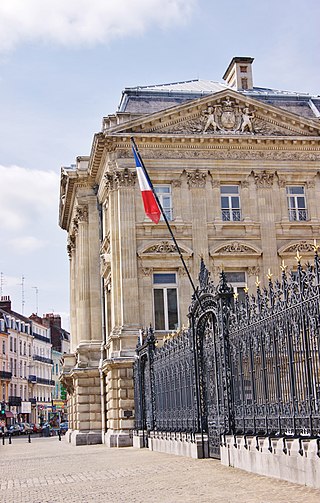
Nord is a département in Hauts-de-France region, France bordering Belgium. It was created from the western halves of the historical counties of Flanders and Hainaut, and the Bishopric of Cambrai. The modern coat of arms was inherited from the County of Flanders.

Wervik is a city and municipality located in the Belgian province of West Flanders. The municipality comprises the city of Wervik and the town of Geluwe. On January 1, 2014, Wervik had a total population of 18,435. The total area is 43.61 km2 which gives a population density of 423 inhabitants per km2. The area is famous for its excellent tobacco and has a tobacco museum. The town is separated from its French counterpart Wervicq-Sud by the river Lys.
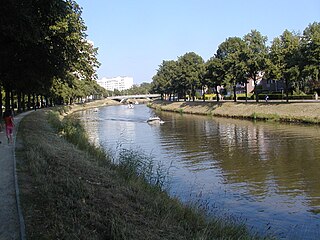
The Lys or Leie is a river in France and Belgium, and a left-bank tributary of the Scheldt. Its source is in Pas-de-Calais, France, and it flows into the river Scheldt in Ghent, Belgium. Its total length is 202 kilometres (126 mi).

Avesnes-sur-Helpe, Picard: Avinne-su-Helpe) is a commune in the Nord department in northern France. It is a sub-prefecture of the Nord department. It is situated 14 km from the Belgian border, and 18 km south of Maubeuge, the nearest larger town. The river Helpe Majeure, a tributary of the Sambre, flows through the town. Upstream of Avesnes on the river there is the Lac du Val-Joly, an artificial lake.

The Métropole Européenne de Lille is the métropole, an intercommunal structure, composed by a network of big cities whose major city is the city of Lille. It is located in the Nord department, in the Hauts-de-France region, northern France – bordering both the Flemish and Walloon regions of Belgium. It was created in January 2015, replacing the previous Communauté urbaine de Lille, and covers that part of the Lille metropolitan area that lies in France. Its area is 671.9 km2. Its population was 1,179,050 in 2019, of which 234,475 in Lille proper. The annual budget of the métropole is €1,865 billion (2018).

Bailleul is a commune in the Nord department in northern France. It is located in French Flanders, 3 km (2 mi) from the Belgian border and 26 km (16 mi) northwest of Lille.

Ogier Ghiselin de Busbecq, sometimes Augier Ghislain de Busbecq, was a 16th-century Flemish writer, herbalist and diplomat in the employ of three generations of Austrian monarchs. He served as ambassador to the Ottoman Empire in Constantinople and in 1581 published a book about his time there, Itinera Constantinopolitanum et Amasianum, re-published in 1595 under the title of Turcicae epistolae or Turkish Letters. His letters also contain the only surviving word list of Crimean Gothic, a Germanic dialect spoken at the time in some isolated regions of Crimea. He is credited with the introduction of tulips into Western Europe and to the origin of their name.
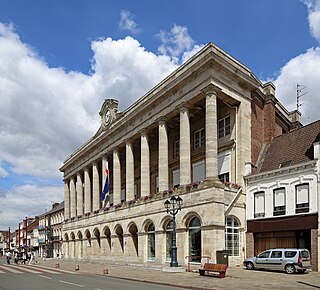
Hazebrouck is a commune in the Nord department, Hauts-de-France. It was a small market town in Flanders until it became an important railway junction in the 1860s. West Flemish was the usual language until 1880, when French was taught at school by mandate of the French government in an effort to "Frenchify" the people of the Nord-Pas-de-Calais and to extinguish their Flemish roots. The development of the railways linked Hazebrouck to Lille to Calais and Dunkirk.

Comines is a commune of the Nord department in northern France.
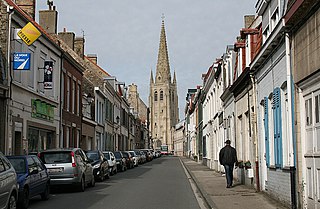
Hondschoote is a commune of the Nord département, in northern France.

The arrondissement of Lille is an arrondissement of France in the Nord department in the Hauts-de-France region. It has 124 communes. Its population is 1,237,472 (2016), and its area is 879.5 km2 (339.6 sq mi).

Aire-sur-la-Lys is a commune in the Pas-de-Calais department in northern France.

Calonne-sur-la-Lys is a commune in the Pas-de-Calais department in the Hauts-de-France region of France.

Warneton is a commune in the Nord department in northern France. It is part of the Métropole Européenne de Lille.

Estaires is a commune in the Nord department of the Hauts-de-France region in northern France.
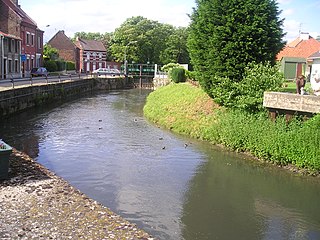
La Gorgue is a town in northern France. It is a commune in the Nord department. The population of La Gorgue in 2019 was 5,639.

Nieppe is a commune in the Nord department in northern France. It is in the Lys Plain and a portion of it is in the Lys Valley.

The Battle of Wervik or of Wervik and Menin was fought on 12 and 13 September 1793 between 30,000 men of the French Army of the North commanded by Jean Nicolas Houchard, and 13,000 Coalition troops: the Veldleger of the Dutch States Army, commanded by the William, Hereditary Prince of Orange and his brother Prince Frederick of Orange-Nassau, and a few squadrons of Austrian cavalry under Pál Kray, seconded by Johann Peter Beaulieu. The great superiority in numbers being on the French side the battle ended in a victory for France, with the Dutch army suffering many losses. Among the casualties was Prince Frederick, who was wounded in the shoulder at Wervik, an injury from which he never fully recovered. The combat occurred during the Flanders Campaign of the War of the First Coalition. Menen is a city in Belgium located on the French border about 100 km (62 mi) west of Brussels.
The canton of Lambersart is an administrative division of the Nord department, northern France. It was created at the French canton reorganisation which came into effect in March 2015. Its seat is in Lambersart.


























